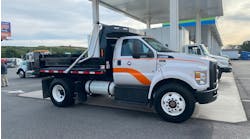When it comes to reducing the nitrogen oxide (NOx) emissions of diesel-burning commercial vehicles, selective catalytic reduction (SCR) is firmly in place as today’s technology. And these systems are not without their challenges when maintaining them. Soon fleets will also have a new technology with which to contend: dual SCR. Coming in the next five years—and according to two OEMs, might very well be the future—dual SCRs will come with their own unique challenges.
How dual SCR differs from today’s catalytic reduction
First let’s talk SCR. Current SCR is itself a quite advanced active emission control technology system that injects a liquid-reductant agent—automotive-grade urea in the form of diesel exhaust fluid (DEF)—into the exhaust stream of a diesel-burning engine. SCR technology is designed to permit NOx reduction to take place in an oxidizing atmosphere. It’s called “selective” because it reduces NOx levels using ammonia (the urea after it is exposed to heat) as a reductant within a catalyst system.
When operating optimally, this aftertreatment technology cuts NOx by up to 90% and meets current U.S. Environmental Protection Agency (EPA) and California Air Resources Board (CARB) standards.
Dual SCR promises perhaps more than 90% reduction, where government rules are almost certain to land in a few years. The question for fleets is how to keep current systems working well enough to perform up to today’s NOx rules? But it’s also critical for them to anticipate what might arrive in their shops to fix in the next five to 10 years.
Think of dual SCR as SCR with an extra urea injector, with designs in R&D that place one injector closer to the engine and one farther away from it. The difference between the two is NOx emissions get processed by the DEF at two locations rather than one.
No heavy-duty truck in production today uses dual SCR. OEMs such as Volvo Trucks and Daimler Trucks North America, and aftermarket manufacturers such as Bosch and Eaton, are all in R&D with dual systems or their likely components. And they all anticipate a tightening of government standards in the U.S. by the EPA and CARB, which is usually even stricter.
Volvo’s director of product marketing, Johan Agebrand, said regulators might also restrict the warmup periods for on-highway diesel engines, which is quite long with SCR, called the “emissions slippage” time. “They won’t be allowed to have a warmup period anymore, no more emissions slippage,” Agebrand said.
Volvo, which is pioneering electric trucks coming into the heavy-duty market, also is a leader in sustainability solutions for trucks that still burn diesel—and dual SCR is no exception, Agebrand said.
Daimler also helped lead the way with SCR in 2007 with the development of its BlueTec emissions technology, said Len Copeland, product marketing manager for Detroit Diesel Corp., a Daimler subsidiary and the OEM’s engine manufacturer.
Copeland touted the existing SCR in Detroit Diesel power plants, its DD13 and DD15 Gen 5 engines, as already-efficient reducers of NOx with their advanced communication among various components. The two engines use asymmetric fuel injection, which “biases” fuel towards different cylinders based on engine load or through a thermal control valve, modulating exhaust flow at low load, high idle, or extended PTO operation to increase exhaust temperatures.
“While dual SCR is newer to the industry, it functions on the same principle and with the same efficiency as existing systems,” Copeland added. Dual SCR “increases NOx conversion due to the two catalysts can also be achieved by increasing the size of a single Diesel Oxidation Catalyst (DOC), where packaging permits. Newer aftertreatment systems, such as the new ATS paired with the heavy-duty Detroit Gen 5 engines, are smaller and lighter (60-plus lb. in this case) than previous generations without increased complexity or cost.”
Any R&D that produces a system that cuts NOx above 90% might be a prescient investment, whichever OEM pioneers it first.
In August, the EPA announced plans to lower greenhouse gas (GHG) emissions and other air pollutants from heavy-duty trucking via several rules over the next three years. All part of the Cleaner Trucks Initiative, the first will be finalized next year and will apply starting with 2027 model year heavy-duty trucks.
The EPA said “from 2007 to 2017, NOx emissions in the U.S. dropped by more than 40%. But there is more work to be done. Heavy-duty vehicles are the largest contributor to mobile-source NOx emissions and will be one of the largest contributors to ozone in 2025. The EPA last revised NOx standards for on-highway trucks and engines in 2001.”
The EPA is also developing ways to strengthen and streamline existing technologies to further reduce emissions. SCR and dual SCR would fall under this category.
The long, long road for aftertreatment systems
The industry has also independently evolved the technology as well. Aftertreatment systems have come a long way in 14 years. With the right training, tools, and understanding of diagnostic procedures, fleets can relieve many of their common pain points.
Copeland said the most recent version of Detroit’s aftertreatment system was released this year to meet GHG Phase 2 regulations.
“With this update, we are able to extend DPF replacement intervals up to 640,000 miles or more while further improving the SCR to increase efficiency at lower temperatures,” Copeland said. “The DOC (diesel oxidation catalyst) has also been improved to allow for lower minimum temperatures during dosing. These improvements help the system clean exhaust better at lower RPMs.”
Volvo’s Agebrand points to other recent aftertreatment system improvements.
“Some major changes include the fact that the SCR catalyst actually does a catalytic conversion in an increased temperature range. Thus, more variety in load and temperature from the engine will still result in a catalytic reduction of NOx emissions,” he explained.
Dosing systems have also improved in both algorithms and hardware. “This enables the systems to operate in a variety of conditions and with higher efficiency,” Agebrand said. “Material production design has also facilitated more compact systems that are easier to service without reducing efficiency.”
Down in the weeds with SCR maintenance challenges
In terms of the maintenance challenges between SCR today and the dual SCR of tomorrow, Volvo’s Agebrand said there should not be too many differences.
SCR maintenance today is concentrated mostly on cleaning or replacing the diesel particulate filter (DPF), “except if fuel is being contaminated,” which might require a deeper dive into repairing other parts of the system, Agebrand said.
Depending on the manufacturer, an SCR system can have multiple filters, complicating the maintenance challenge, said Ryan Koukal of Clean Diesel Specialists.
With any filter, maintenance intervals also are important to make sure they are doing their job properly, he said. “We always suggest the customer check with the manufacturer to confirm where each filter is and its suggested replacement interval,” he told Fleet Maintenance.
So much else on a current SCR system can fail, thus requiring a maintainer’s attention, Koukal added.
A system’s DEF pump is a key cog in the system’s efficiency. “It all starts at the pump. If the pump is not operating properly, the DEF injector may plug and fail or you may get a buildup of dried DEF in the decomp tube and/or SCR,” he said.
The DEF injector—there would be two in a dual SCR system—should be removed and inspected when filters are being serviced. “Dried DEF buildup can lead to poor DEF atomization, which can lead to poor SCR conversion efficiency,” Koukal added.
He advised to not overlook the air dryer filter in a current SCR.
“In many OEM applications, air is used to purge the DEF lines of any residual fluid. If the air filter is dirty, old, or cheap, it may contaminate the DEF system, causing further issues,” Koukal explained. “It is highly recommended to use a coalescing filter ONLY, as cheaper filters may still allow small contaminants to pass through it.”
An SCR system, by design, depends on heat to work properly. Exhaust leaks, another piece of the SCR maintenance checklist, equal temperature loss, Koukal noted. Temperature loss results in poor DEF decomposition, which then leads to poor SCR conversion efficiency, he said.
Also, he said, temperature and NOx sensors are the most replaced component in the aftertreatment system. While maintenance is not really an option, there’s an emerging industry of aftermarket solutions.
In terms of maintenance disadvantages of dual SCRs, a maintenance technician with Aim NationaLease and a past TMC SuperTech competitor, John Norwood, said he sees only a few possible disadvantages to dual SCR over the current SCR systems: an increase in DEF consumption and added sensors and catalyst that could fail. “If an upstream contamination happens, that adds to what it could contaminate.”
Norwood’s and others’ prevailing attitude: Follow what government regulators do. If a future dual SCR gets you there, your fleet should adopt it. Right now, SCR is the standard and OEMs have brought it a long way, but dual SCR is something to watch.




